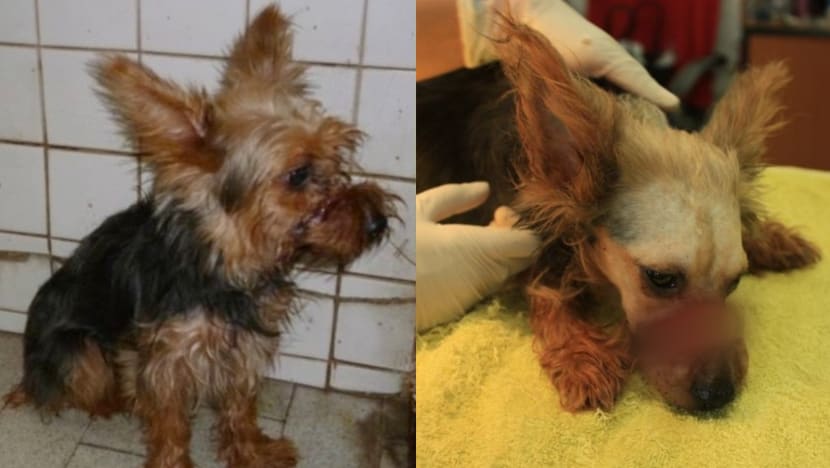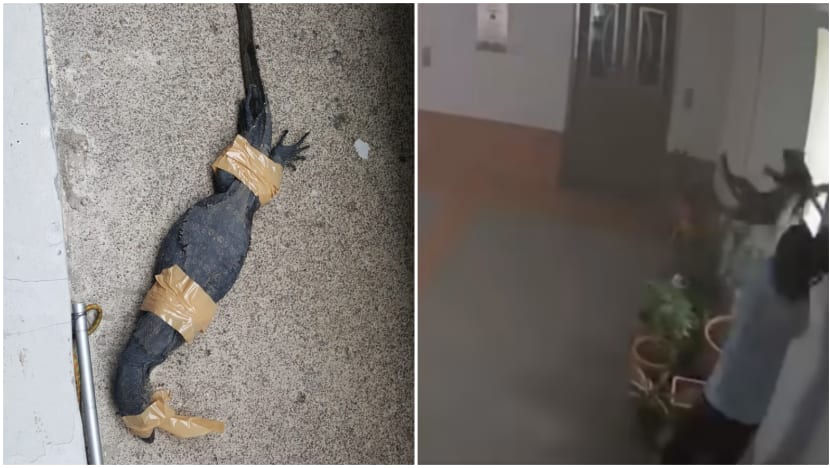IN FOCUS: Why are people cruel to pets and wildlife?
From an act of retaliation to more complex psychiatric issues, animal abuse can also stem from a lack of exposure to nature and wildlife.

A silky terrier was found with a rubber band around its muzzle. (Photos: SPCA Singapore)
(Warning: Some people may find the following images disturbing)
SINGAPORE: Of all the rescues Mr Lee Yao Huang has been a part of in his 15 years at the Society for the Prevention of Cruelty to Animals (SPCA), one case stands out.
A silky terrier was found wandering in a Housing and Development Board void deck in Clementi, its muzzle sealed shut with a rubber band.
By the time it was rescued, the rubber band had cut to the bone – the 3cm wide wound around the small dog’s snout was devoid of flesh and had begun to rot and stink.
It was a cruel way of stopping the dog from barking.
"As an animal, I mean how would you feel if your mouth is sewed up or tied up? And you can’t eat, you can’t drink, you can’t communicate," said Mr Lee, who is SPCA’s head of operations.
Cases like this are not uncommon. Figures released by SPCA last week showed that the number of animal welfare and cruelty cases was at its highest last year since 2020. There were 481 cases in 2020, 324 in 2021 and 511 last year.
In the first three months of this year, SPCA has received 229 cases. If this continues, the SPCA expects to receive 800 cases by year-end, the charity’s executive director Aarthi Sankar told CNA.
Cases of horrific abuse have grabbed headlines in the past six months – one involved a child who threw a cat off a lift landing, and another was a group of men who brutalised a python in Boon Lay.
CNA spoke to mental health professionals, animal welfare groups and the authorities about what drives people to abuse animals, if such acts can be prevented, and how they are investigated.

UNDERLYING MENTAL HEALTH ISSUES
Whether it is a person striking at a snake in fear or an angry owner disciplining a pet with a heavy hand, cruelty can stem from a simple act of retaliation or more complex psychiatric issues.
There is also a wide range of motivations not linked to psychiatric issues. A lack of awareness about proper care for animals, certain cultural and socio-environmental attitudes, or latent emotions triggered by other events can contribute to abusive behaviour, said clinical psychologist Annabelle Chow.
When linked to underlying mental health conditions, experts said impulsivity, poor emotional regulation and a lack of empathy were among the main drivers of abusive behaviour towards animals.
These characteristics often manifest in those with psychiatric conditions, such as antisocial personality disorder in adults.
Those who have this disorder are aggressive towards others and are prone to acts of violence, whether physical or verbal, said psychiatrist Adrian Wang.
“The main problem is that their core value system is wrong. So they cannot fit into society because they only think about themselves. They often derive pleasure from seeing others suffer,” Dr Wang.
“Although it is classified as a psychiatric disorder, it doesn't legitimise this behaviour. It implies a character flaw where the core feature is a lack of empathy and remorse.”
Psychiatrist Lim Boon Leng concurred that people with antisocial or psychopathic features have little empathy towards animals.
These people are more willing to victimise animals as their actions do not affect them, and the animals’ availability and helplessness make them easy targets, Dr Lim said.
“We're talking about whether the victims can expose the perpetrator. The animals cannot expose the perpetrator, so these are very ‘low-risk’ victims, so to speak. I think that’s why they keep going back to animals,” he added.
Dr Wang also linked lower impulse control to individuals with a low IQ or those with intellectual disabilities.
These people can fail to understand the context of their behaviour, Dr Wang said. "You need some higher brain function to control, to manage your emotions, so those with low IQ, they have more anger outbursts.”
Dr Jacob Rajesh, a senior consultant psychiatrist at Promises Healthcare, said that individuals with low IQ may have low frustration tolerance.
“They're more impulsive. I've seen one or two cases where they quite badly hurt a cat. It's not very common, but it can happen,” he said.
Drawing on studies which have shown links between domestic violence and animal abuse, experts also pointed out that abusers could have been victims themselves.
"Abusers often share some characteristics and experiences. These can include a history of early traumatic experiences such as abuse, neglect, or substance abuse, as well as a history of domestic violence or bullying," said Dr Chow.
If left unchecked, cruel behaviour may escalate in frequency and severity, and may also be projected on fellow humans, the experts said.
"If you can be cruel towards animals, it shows that there is a lack of empathy, so when there is a lack of empathy, it is likewise the same when you treat other human beings,” said Dr Lim.
“When you have a lower level of empathy, you don't feel the pain that other people may feel and therefore it’s easier for you to inflict pain on them.”
These people may target vulnerable victims in their households who are least likely to complain, such as children, he added.
LACK OF EXPOSURE LEADS TO INTOLERANCE
Some people decide to take matters into their own hands and hurt animals when they intrude into living spaces.
Animal Concerns Research and Education Society (ACRES) co-CEO Anbarasi Boopal said she has come across such situations.
The animal welfare charity saw 69 wildlife-related cruelty cases in 2019, 49 in 2020, 86 in 2021 and 56 last year.
In a situation where people encounter wild animals in unexpected places, some who try to remove the animal inevitably end up hurting it instead, said Ms Anbarasi.
She cited an incident a few months ago where a teacher poured boiling water on a paradise tree snake that was found in a preschool, and the snake died.

Other cases that ACRES attended in the past three years include a monitor lizard bound with masking tape, a pigeon embedded with darts, as well as an iguana with its limbs tied.
“Somehow when it comes to animals like snakes and monitor lizards, people tend to put their fear in front and any actions done to them become justifiable,” said Ms Anbarasi.
“That is our biggest worry – we find that deterrence is not adequate. We need more awareness, we need more tolerance, and understanding that if you’re so scared of the snake, you should not be getting close (to it) in the first place.”
These animals are misconceived in a society where human experiences with nature are “controlled” and “manicured”, or where their only exposure to animals is through the media, said Ms Anbarasi.
“The bottom line is it’s a learned fear that we all have, whether it’s from movies or certain portrayals of snakes on mainstream media – words like dangerous, aggressive, venomous, toxins ... there are certain terms that are associated with certain groups of animals.”
When people observe ACRES officers holding a snake, they find that it is not as scary as they first perceive it to be, she said, adding that no wild animal in Singapore preys on humans.
This intolerance towards animals perceived to be dangerous was seen in a recent incident when a reticulated python was brutalised outside Boon Lay Place Market.
In a video posted on ACRES’ Facebook page in April, a group of men were filmed kicking, grabbing the python by its tail and hitting it with crates and pails.
The men laughed throughout the incident, which ended with one of them chopping and killing the snake with a cleaver.

When asked why some people love certain animals but hate others, experts said animals are perceived differently, with some treated as dangerous.
“Many people are repulsed by snakes and they see it as something evil and bad. Snakes in folklore are seen as repugnant and evil things, but biologically it’s just another animal,” said Dr Wang.
In cases where a group of people is involved, a ring leader with a “strong personality” may influence others to just follow along, Dr Wang said, adding this was often seen in gang fights.
Dr Rajesh pointed out that mob mentality might have been at play in the recent python incident.
“When somebody attacks, tries to kill a snake, you may find other passers-by also coming in and trying to kill the snake along with them,” he said.
“You have four or five big men attacking a python, so you have this power of control or maybe they get satisfaction in inflicting violence on the python, and they know that the python can’t do anything back to them.
“It's probably a combination of peer pressure, mob mentality, and then their own ... emotions being displaced.”
Senior forensic psychologist at Promises Healthcare June Fong added that there is a diffusion of responsibility when individuals are in a group.
“So even though you know that killing an animal is wrong, you don't feel personally responsible for it because everyone else is doing it. And that will reduce your inhibitions,” she said.
Cat Welfare Society (CWS) president Thenuga Vijakumar said cats used to be seen as pests, in part because there were too many strays.
“Back when I started volunteering, the CWS saw a lot more community cats on the streets and there was overpopulation just in the community.
“That led to insufficient resources (to care) for the animals, and a great deal of irritation towards the cat because the sheer numbers would cause and pose a nuisance to people,” she explained.
Irresponsible cat feeding also contributed to the image of the cat as “dirty”, as people would throw around food for the cats.
These days, people see cats being cared for in a clean and responsible way, and a more positive association is formed, she said.
“Over time as the sterilisation programme has matured and more caregivers have stepped up, we see that the population on the ground is more controlled.
“So there are fewer instances of acting out ... against the sheer number of cats,” added Ms Thenuga, who owns five cats.
“Instead, what we're seeing now, it looks more like mental health issues and the fact that community cats are a very easy target.”
CASES OF YOUNG ABUSERS WORRYING
Cases involving youth and children were rare before 2022. The SPCA received seven such reports last year, and two this year so far.
"The scary thing is that the nature of these cases, more than the fact that it involves minors, is that it involves intentionally inflicting harm and pain,” she said, adding that the incidents went beyond usual curiosity and inquisitiveness.
"An inquisitive mind is when you want to go and touch a dog to feel what it feels like, or you want to touch a snake because it looks slithery to you.”
She attributes the phenomenon to a "novelty element", where children replicate what they see on social media – such as pranks on pets – for fun or amusement.
“I can't even say curiosity because I look at it ... force-feeding a cat a cigarette, nothing much there for you to be curious (about),” said Ms Aarthi.
Other experts said that children can act out of ignorance as they are unaware of the consequences of their behaviour.
"If the parents are also cruel and punish the animal, (children) may also do likewise," said Dr Lim.
"Sometimes they feel that it's the right thing to do because they are maybe training the animals and trying to prevent the animal from getting into major situations, and by hitting the animal they feel that is the right way to train the animal."
Immaturity in children can result in them failing to distinguish right from wrong and acting in a callous way, he said.
"There can also be situations where ... they are being cruel and they are projecting their anger, projecting their anxieties or even sometimes, just getting pleasure and kicks out of being cruel to the animal,” added Dr Lim.
In more serious cases, children may have conduct disorder, psychiatrists noted.
Dr Rajesh said that these are children who behave badly, lie or play truant from school and tend to be aggressive or violent towards other children and property.
"So as part of conduct disorder, they may also hurt animals. Conduct disorder can evolve into antisocial personality disorder (in adulthood) where they may continue their crimes," said the psychiatrist, adding that these people may lack remorse and empathy.
Asked how such traits come about, psychiatrists said it could be a mix of genetics and other factors, such as growing up in a dysfunctional family where violence is normalised.
“Environmental influences for violence or aggression are possible and prevalent in today’s age, beyond bullies, aggressive peers or family members and caregivers,” said Dr Chow.
“It is possible for children or teens to be exposed to violence or aggressive behaviours from the internet, given the reach and the content of such behaviours circulating.”

CAN YOU TREAT ABUSIVE BEHAVIOUR?
A person may show signs if they are planning to abuse an animal, Promises Healthcare’s Ms Fong said.
“They might, for instance, search (online) for ways to harm an animal or how to dispose of an animal carcass,” she added.
“If children and teenagers post on social media, or like videos where animals are being tortured and support animal cruelty, those would also be some clues.”
Most acts are opportunistic and impulsive, with intervention possible only after an act of abuse has been committed.
Dr Chow said perpetrators present complex histories, circumstances, and motivations, with intervention depending on the root cause of the abuse.
Psychological intervention would begin with an assessment of the offender’s history.
For example, she has a patient with childhood trauma who strangles and hits her pet cats in anger and frustration. Part of Dr Chow’s treatment includes helping the patient understand her emotions, forgive her past and explore healthy ways to vent her emotions.
Psychiatrically, there is no one-size-fits-all solution, said Dr Wang, adding that counselling and therapy form the bulk of the treatment.
"Long-term counselling is needed because we need to help them understand that their behaviour causes hurt to others," he added.
For children suspected to have conduct disorder, family intervention has been found to be useful, said Dr Lim.
It is possible for children to cut down on deviant behaviour through therapy with their parents, he said, adding that children’s personalities are not yet “consolidated” at their age.
"It's more of therapy, structured therapy, setting boundaries, setting rules," said Dr Rajesh, adding that those with intellectual disabilities can be taught skills to improve communication.
Ms Fong and Dr Rajesh said that putting patients through cognitive behavioural therapy may help them develop empathy and evaluate the consequences of their actions.
Experts generally concur that incarceration may be the only solution in cases where there is repeat behaviour and counselling fails. A jail term will send the message to potential offenders that abusive behaviour will not be tolerated.
SPCA and ACRES stress that attitudes towards animals should be shaped from a young age, through education and positive interaction with animals.
LISTEN:
INVESTIGATING ANIMAL ABUSE CASES
The Animal and Veterinary Service (AVS), which comes under the National Parks Board, has investigated an average of about 1,250 alleged cruelty cases a year since 2019.
About 5 per cent of these cases, which include neglect, abandonment and abuse cases, lead to enforcement actions such as composition fines, warning letters or prosecution in court.
The remainder of the cases consist mostly of neighbourly disputes, animals involved in road traffic accidents or others involved in fights with stray animals, AVS’ director of investigations Joshua Teoh told CNA.
Upon receiving reports, AVS investigation officers interview witnesses and work with animal welfare groups, clinics, and other government agencies. They may also conduct raids, depending on the cases.
Some common ones it sees are pet owners who neglect their pets by subjecting them to inadequate living conditions, Mr Teoh said.
"Based on what we have gathered and observed from past cases, I think what we can say is that most of the owners lack the knowledge and awareness on what they can do to properly take care of the animals," he added.
"So for all these, we go the educational route, we ensure that we teach them the correct thing and tell them how to be a responsible pet owner, what are the things you should and should not do. Most of them, they are receptive and then they become better owners."
Among the challenges AVS faces during investigations include the lack of evidence or eyewitnesses. Sometimes, officers have to rely on circumstantial evidence, such as a weapon used to commit the act, or post-mortem reports of the animal.
The SPCA currently has four rescue officers and an inspector who handle its cases. Apart from rescues, the animal welfare charity also looks into reports of neglect, abuse and abandonment, with cases taking between a week and up to two years to resolve.
When SPCA officers intervene, people accused of abuse sometimes become "very defensive".
Ms Aarthi brought up a case where two boys were walking their dogs, and one of them was filmed pulling a small dog up by its leash, suspending it in mid-air.
“We reached out and asked the authorities to join us in counselling these children because this was a fine line between, ‘do you know how to care for your dog’, and ‘are you being cruel’.
“(The boys) came with the father and the father was very unhappy that his sons were in this situation.
“He was trying to justify (his sons’ actions) to us and we always end up in this very difficult spot where he will say ‘oh, there's actually a harness, so what's wrong with me lifting the dog up like this?’
“You realise they learn this from the parent.”
Some cases cannot proceed because of a lack of evidence, Ms Aarthi and Mr Lee told CNA.
There are also animal lovers who get emotional so they cremate the abused animals, removing the biggest evidence the SPCA needs to proceed with cases, Mr Lee said.
In some cases, cruelty is not detected until it is too late. Mr Lee recalled a dog that had been starved for months and the dog’s carcass was “skin and bones” by the time it was handed over to the SPCA.
.jpg?itok=3G4uiSNo)
In 2014, the dog’s owner was given the then-maximum fine of S$10,000 (US$7,551) under the Animals and Birds Act.
The SPCA had asked for the owner to be jailed, describing the fine as “insufficient for such an extreme and torturous act of neglect and cruelty against an innocent and defenceless animal”, TODAY reported.
Echoing those sentiments, Ms Aarthi called for stiffer penalties and for an offender to be barred from owning pets for life. Currently, offenders can be disqualified from owning pets for up to a year.
According to a written parliamentary reply by the Ministry of National Development in March, 11 disqualification orders were issued against animal cruelty offenders in 2022.
Under the current Animal and Birds Act, those found guilty of animal cruelty can be jailed for up to 18 months, fined up to S$15,000, or both. Repeat offenders can face a jail term of up to three years, a fine of up to S$30,000, or both. They may face stiffer punishment if they are employed in an animal-related business.
In the case of the silky terrier that had its muzzle tied up, the perpetrator was never identified.
“Luckily the dog recovered under our care and got adopted a few months later,” Mr Lee said with a smile.
Read this story in Bahasa Indonesia here.


















